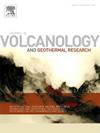The fate of an extremely phenocryst-rich magma in producing small sub-Plinian plumes during the 17th and 30th April 2024 eruption of Mt. Ruang (North Sulawesi, Indonesia): The role of clast density
IF 2.3
3区 地球科学
Q2 GEOSCIENCES, MULTIDISCIPLINARY
Journal of Volcanology and Geothermal Research
Pub Date : 2025-04-14
DOI:10.1016/j.jvolgeores.2025.108332
引用次数: 0
Abstract
After ∼22 years of dormancy, two vigorous sub-Plinian eruptions occurred at Mt. Ruang (North Sulawesi, Indonesia) on April 17th and 30th 2024, with an observed plume height of 9–12 and 19 km, respectively. Petrography and whole-rock XRF analysis reveal that Ruang pumices are extremely rich in phenocrysts (0.36–0.87 ; plagioclase>amphibole>pyroxenes>olivine>oxides) and dense (1.31–2.33 g/cm3), with SiO2 contents of 54.0–56.3 wt%. This suggests that the eruption was sourced by an extremely crystal-rich basaltic-andesite magma reservoir. The magma likely received substantial recharge from the deeper-hotter source as evidenced by the prevalence of amphibole megacryst, crystal clots, and disequilibrium phenocryst textures (i.e., reverse zoning, oscillatory zoning, and fine sieves). Ash from the 17th and 30th April 2024 eruptions are classified as very fine ash (median of 29 and 26 μm, respectively) and exhibit a blocky characteristic (0.75–0.99 convexity and 0.71–0.98 solidity). This evidence, coupled with the presence of stepped surface and hackle marks textures strongly suggests the involvement of external water during the eruption. The fact that Ruang pumices are characterized by high matrix-vesicle and feldspar microlite number density values (log ∼15 m−3) suggests that the magma decompression was rapid, reaching 0.05–27 MPa/s. However, despite this condition, the eruption was only able to generate relatively small sub-Plinian plumes. By consulting with the huge dataset from other previous studies, we found that plume height shows a negative correlation with phenocryst content and bulk density, with Ruang pumices having the highest phenocryst content and bulk density variations. This suggests that; besides magma decompression rates and magma-water interaction, the pre-eruptive crystallinity condition within the magma reservoir is essential for controlling the plume height and hence might be used as a proxy to predict the intensity of future eruptions.
2024年4月17日至30日印度尼西亚北苏拉威西的阮山火山喷发期间,一种极富斑晶岩浆在产生小的次普林尼期岩浆柱中的命运:碎屑密度的作用
经过大约22年的休眠,2024年4月17日和30日,印度尼西亚北苏拉威西的阮山(Mt. Ruang)发生了两次剧烈的次普林尼期喷发,观测到的羽流高度分别为9-12公里和19公里。岩石学和全岩XRF分析表明,黄浮岩斑晶含量极丰富(0.36 ~ 0.87 ф;斜长石、角闪石、辉石岩、橄榄石、氧化物等)致密(1.31 ~ 2.33 g/cm3), SiO2含量为54.0 ~ 56.3 wt%。这表明这次喷发的来源是一个极富晶体的玄武岩-安山岩岩浆储层。岩浆很可能从更深层、更热的岩浆源获得了大量补给,这一点可以从角闪洞巨晶、结块和不平衡斑晶结构(即逆分带、振荡分带和细筛)的普遍存在中得到证明。2024年4月17日和30日喷发的火山灰为极细火山灰(中值分别为29 μm和26 μm),呈块状特征(凹凸度为0.75 ~ 0.99,固体度为0.71 ~ 0.98)。这一证据,再加上台阶状表面和棘纹纹理的存在,强烈表明火山喷发期间有外部水的参与。阮氏浮石具有高基质囊泡和长石微岩数密度值(log ~ 15 m−3)的特征,表明岩浆减压速度快,达到0.05 ~ 27 MPa/s。然而,尽管如此,这次喷发只产生了相对较小的次普林尼亚羽流。通过查阅前人研究的大量数据,我们发现羽流高度与斑晶含量和容重呈负相关,其中阮氏浮石的斑晶含量和容重变化最大。这表明;除了岩浆减压速率和岩浆-水相互作用外,岩浆储层内爆发前的结晶度条件对控制岩浆柱高度至关重要,因此可以作为预测未来喷发强度的一个指标。
本文章由计算机程序翻译,如有差异,请以英文原文为准。
求助全文
约1分钟内获得全文
求助全文
来源期刊
CiteScore
5.90
自引率
13.80%
发文量
183
审稿时长
19.7 weeks
期刊介绍:
An international research journal with focus on volcanic and geothermal processes and their impact on the environment and society.
Submission of papers covering the following aspects of volcanology and geothermal research are encouraged:
(1) Geological aspects of volcanic systems: volcano stratigraphy, structure and tectonic influence; eruptive history; evolution of volcanic landforms; eruption style and progress; dispersal patterns of lava and ash; analysis of real-time eruption observations.
(2) Geochemical and petrological aspects of volcanic rocks: magma genesis and evolution; crystallization; volatile compositions, solubility, and degassing; volcanic petrography and textural analysis.
(3) Hydrology, geochemistry and measurement of volcanic and hydrothermal fluids: volcanic gas emissions; fumaroles and springs; crater lakes; hydrothermal mineralization.
(4) Geophysical aspects of volcanic systems: physical properties of volcanic rocks and magmas; heat flow studies; volcano seismology, geodesy and remote sensing.
(5) Computational modeling and experimental simulation of magmatic and hydrothermal processes: eruption dynamics; magma transport and storage; plume dynamics and ash dispersal; lava flow dynamics; hydrothermal fluid flow; thermodynamics of aqueous fluids and melts.
(6) Volcano hazard and risk research: hazard zonation methodology, development of forecasting tools; assessment techniques for vulnerability and impact.

 求助内容:
求助内容: 应助结果提醒方式:
应助结果提醒方式:


